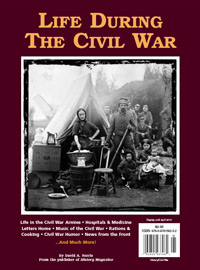I’m now writing for Family Chronicle, and while corresponding yesterday with publisher Ed Zapletal, he told me about a  new publication from Moreshead Magazines Ltd that will be widely available within a few days. Ed sent me a PDF of the 95-page publication, allowing me to do a pre-pub review. The title of the publication is Life During the Civil War. It’s written by David A. Norris, who has written extensively for their History Magazine publication, as well as many other periodicals.
new publication from Moreshead Magazines Ltd that will be widely available within a few days. Ed sent me a PDF of the 95-page publication, allowing me to do a pre-pub review. The title of the publication is Life During the Civil War. It’s written by David A. Norris, who has written extensively for their History Magazine publication, as well as many other periodicals.
The publication starts right off with a 3-page dictionary of Civil War terminology. Did you know that hardtack crackers were often called worm castles? Further on, Norris points out that the hotel business boomed during the war years. My great-grandfather ran a hotel throughout the war, and did well. However, I’d never made the connection with the war effort before. The chapter on music I found especially interesting. Among other things, it’s noted that “Dixie” was written by Yankee abolitionist Daniel Decatur Emmett. The mail was a big deal to both the soldiers and their loved-ones at home. This was the case for both Northern and Southern families. However, keep in mind that when the Confederacy split from the Union, it had dramatic repercussions on the U.S. postal system. I found the entire booklet to be interesting – front to back. I’ve included the table of contents in this blog so you can get the gist of what is in store. I recommend it. At only $9.95 (plus $4.50 postage), it’s a good deal too. Click here to order. Other than being a friend of the publisher, I have no vested interest in this publication, and get nothing for writing this blog – other that the satisfaction of doing so.
The following is from the table of contents.
- OPENING NOTES
Notes From the Publisher, About the Author - FROM ABATIS TO ZOUAVES: A CIVIL WAR DICTIONARY
What were some of the popular sayings, slang, jargon and military terms in the 1860s? - TALE OF TWO CAPITALS: RICHMOND AND WASHINGTON
The war brought great changes to the lives of residents of Richmond and Washington - HOME AWAY FROM HOME: HOTELS OF THE CIVIL WAR
From four-star resorts to small town hostelries, hotel business boomed during the war - SOUNDTRACK TO A CONFLICT: MUSIC OF THE CIVIL WAR
Music, whether popular songs or military tunes, was as much a part of life then as it is now - STARVATION PARTIES AND CONFEDERATE CANDLES?
Southerners found unusual substitutes for scarce staples, like wheat, pins, shoe polish and coffee - SLUMGULLION, SALT HORSE AND HELL-FIRED STEW!
What did soldiers, and their families at home, eat during the war years? - RELIEF FROM REALITY: CIVIL WAR HUMOR
Popular humorists and jokes helped lighten hearts on both sides of the battle - SHINPLASTERS AND GREENBACKS: MONEY DURING THE CIVIL WAR
Banks, businesses, states, the Union and Confederacy all issued their own, incompatible, money - ZOUAVES: NEW YORK FIREMEN AND LOUISIANA TIGERS
Instead of the familiar blue and gray, some regiments donned bright colors and turbans - MAN’S BEST FRIENDS: PETS IN THE ARMY
From the exotic to the common, animals were kept as companions and mascots - JOHNNIE REB AND BILLY YANK: LIFE IN THE ARMIES
Fresh recruits and veterans of past conflicts faced new, and familiar,challenges in the Civil War - FIGHTING FOR FREEDOM: THE US COLORED TROOPS
African-American troops played a vital role in the Civil War - SUTLER SHOPS: CONVENIENCE STORES FOR SOLDIERS
Where did soldiers get ink, ginger snaps or Valentine cards? - LIFE ON SOAP SUDS ROW: ARMY LAUNDRESSES
Laundry was a grueling, but essential, duty in army camps - TAKING THE CARS: RAIL TRAVEL DURING THE CIVIL WAR
Though far from luxurious, or safe, trains became vital to the war effort and civilian life - WHAT THE DOCTOR ORDERED: HOSPITALS AND MEDICINE
Hospitals were understaffed, undersupplied and relied on dangerous cures and treatments - COMMON CIVIL WAR MEDICINES
Hospitals stocked standard treatments of the day, including mercury, opium and brandy - FUNDRAISING FAIRS: THE US SANITARY COMMISSION
Volunteer groups raised millions of dollars to improve military hospital and camp conditions - PICTURING THE CIVIL WAR: WAR ARTISTS
Before modern photography and TV, how did people get a glimpse of the battles? - FROM THE FRONTLINES TO THE HOMEFRONT: NEWSPAPERS
Despite shortages of labor and ink, papers fed the public appetite for news and entertainment - TELEGRAMS: AT THE SPEED OF LIGHTNING
The telegraph became an indispensible part of military and commercial communication during the war - WORTH A THOUSAND WORDS: PHOTOGRAPHY IN THE CIVIL WAR
Despite technological limitations, photography boomed during the Civil War - “I HAIN’T GOT ANY STAMPS”: CONFEDERATE AND UNION MAIL
Two postal systems kept soldiers and families in contact across shifting battlelines - THE CIVIL WAR NAVIES: COTTONCLADS AND BLOCKADES
Whether they patrolled rivers or the South Pacific, a sailor’s life was far different than a soldier’s - THE NEW NAVAL WARFARE: LIFE ON IRONCLADS
Heavily armored ironclads offered unique advantages, and dangers, to their crews - MISSED IT BY THAT MUCH…!
From aseptic surgery to moon landings, the years after the Civil War were full of amazing changes